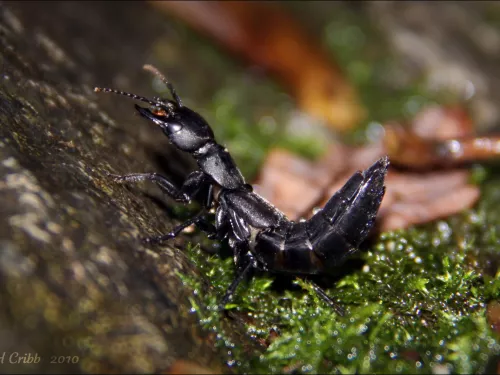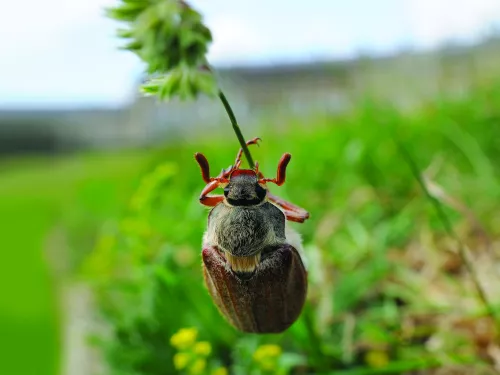Black snail beetle
This shiny beetle is common in wooded areas throughout the UK. As the name suggests, it specialises in hunting snails.

Trying to identify a beetle in Kent? Learn about some of the most common types in our handy species explorer.
This shiny beetle is common in wooded areas throughout the UK. As the name suggests, it specialises in hunting snails.
These distinctive beetles are often found around dead birds and small mammals.
The Coppery click beetle is a large, coppery-purple beetle with straw-brown wing cases. It can be found on grassland and farmland, and its larvae are known to feed on roots and damage crops.
The violet click beetle is a very rare beetle that lives in decaying wood, particularly common beech and ash. It gets its name from its habit of springing upwards with an audible click if it falls on its back. It is found at just three sites in the UK.
The Great diving beetle is a large and voracious predator of ponds and slow-moving waterways. Blackish-green in colour, it can be spotted coming to the surface to replenish the air supply it stores beneath its wing cases.
So-named for its three bull-like horns, the Minotaur beetle is a large dung beetle found on grassland and heathland from the autumn. Adults drag dung back to their nests for their larvae to feed on.
This metallic green beetle can be seen visiting flowers on sunny days in spring and summer.
A bright red beetle, with black legs and knobbly antennae, the red-headed cardinal beetle lives up to its name. Look for it in woodland, along hedgerows and in parks and gardens over summer.

The glow-worm is not actually a worm, but a beetle. Males look like typical beetles, but the nightly glow of a female is unmistakeable - lighting up to attract a mate in the darkness of their grassland habitats. Look for the adults in summer.
A ferocious and agile predator, the green tiger beetle hunts spiders, ants and caterpillars on heaths, grasslands and sand dunes. It is one of our fastest insects and a dazzling metallic green colour.
Violet ground beetles are active predators, coming out at night to hunt slugs and other invertebrates in gardens, woodlands and meadows.
Our most common ladybird, the black-on-red markings of the 2-spot Ladybird are familiar to many of us. Ladybirds are beneficial insects, managing garden pests - encourage them by putting up a bug box.
The large eyed ladybird is unmistakeable: it is our only ladybird with yellow rings around its black spots. Ladybirds are beneficial insects, managing garden pests - encourage them by putting up a bug box.
One of our most common ladybirds, the black-on-red markings of the 7-spot ladybird are very familiar. Ladybirds are a gardeners best friend as they eat insects that love to nibble on garden plants! You can encourage them into your garden by putting up a…
The orange ladybird is pale orange with up to 16 cream spots on its wing cases. It feeds on mildew on trees like sycamore and ash, and hibernates in the leaf litter. It often turns up in moth traps.
A non-native species originating from Asia, the harlequin ladybird is prevalent in towns and gardens.
The 14-spot ladybird is one of three yellow ladybirds in the UK. Look for it in grassland, woodland and gardens. Ladybirds are beneficial insects, managing garden pests - encourage them by putting up a bug box.
The 22-spot ladybird is one of three yellow ladybirds in the UK. Look for it in grassland, woodland and gardens. Ladybirds are beneficial insects, managing garden pests - encourage them by putting up a bug box.
The common name of the Bloody-nosed beetle derives from its unusual defence mechanism: when threatened, it secretes a distasteful blood-red liquid from its mouth. This flightless beetle can be found on grassland and heathland, and along hedgerows.
When threatened, the Green tortoise beetle acts just like a tortoise, pulling its feet and antennae in and hunkering down, gripping the leaf it is on as tightly as possible. Look for it on White Dead-nettle in gardens and hedgerows.
This jewel like leaf beetle is an incredibly scarce species which is only found in wetland habitats.
This beautiful beetle only arrived in the UK in 1960s but is now a common sight on garden herbs.
The metallic-green Musk beetle lives up to its name: it releases a musky-smelling secretion when it defends itself. It is a longhorn beetle, so has lengthy antennae. Look for it near wetlands in summer.
A clever mimic, the wasp beetle is black-and-yellow and moves in a jerky, flight-like fashion - fooling predators into thinking it is actually a more harmful common wasp. Look for it in hedgerows and woods in summer.
This brightly-coloured beetle is often found feeding on flowers on warm days in late spring and summer.
These bulky beetles can sometimes be found on flowers in woodland rides or along hedgerows.
This beautiful beetle is fond of damp meadows and woodland rides, where it's often found on umbellifers or thistles.
The Common sexton beetle is one of several burying beetle species in the UK. An undertaker of the animal world, it buries dead animals like mice and birds, and feeds and breeds on the corpses.

A ferocious and fast predator, the Devil's coach horse beetle hunts invertebrates after dark in gardens and on grasslands. It is well-known for curling up its abdomen like the tail of a scorpion when defending itself.

This large, brown beetle can be seen swarming around streetlights in spring. They live underground as larvae for years and emerge as adults often in large numbers. Listen for their characteristic buzzing sound.
The rose chafer can be spotted on garden flowers, as well as in grassland, woodland edges and scrub.
The Noble chafer is a rare and beautiful metallic-green beetle that can be found in traditional orchards. It is on the wing over summer, feeding on umbellifers. The larvae live in the decaying wood of old trees.
One of our largest soldier beetles, often found on flowers where they hunt other insects.
The common red soldier beetle is also known as the 'bloodsucker' for its striking red appearance, but it is harmless. It is a beneficial garden insect as the adults eat aphids, and the larvae eat other pests.
Famous for its fearsome jaws, the stag beetle does not have the bite to match. Look for it in woods, parks and gardens in South East England in summer. Males display their massive jaws to attract females and duel with their rivals.
The lesser stag beetle may be smaller than its famous cousin, but it is still a large beetle with large jaws. It can be seen in woods, parks and hedgerows during summer, and depends on dead wood.
The rhinoceros beetle lives up to its name by sporting a distinctive 'horn' on the males' head. This glossy, blue-black beetle can be found in woods, parks and hedgerows, and depends on dead wood.
Ever wondered what that little black dot whirling in circles on the top of the water of a pond is? Those are whirligig beetles! Often seen shooting across the water surface on the hunt for its next meal.
Famed for its tapping in the middle of the night, supposedly heralding tragedy, the Deathwatch beetle is a serious wood-boring pest. In houses, their tunnelling can cause major damage.